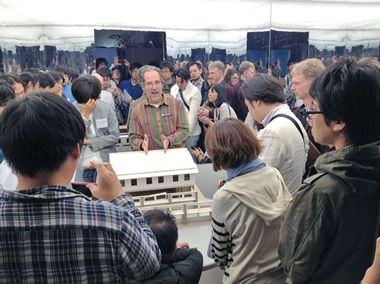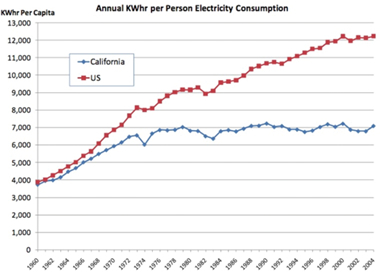While the first workshop’s aim was to get hands-on experience with an integrated approach to designing buildings for low energy use and high occupant comfort, the main themes of AEJ-2012 were to introduce simulation software, discuss the differences in energy policies between Japan and California, work on a real design project and exchange views on education systems. I will concentrate here mainly on two themes: policies and simulation techniques.
In California there are incentives for energy supply companies to promote reduction in energy use. This is a significant difference with the way Japan is dealing with the issue of reducing energy consumption. As mentioned earlier, after the second Oil Shock in 197,9 California went on to create an innovative system on the energy supply end, called “decoupling.” This policy’s most significant aspect is the fact that at a political level a cap is set on the allowable profits on energy each year by the California Public Utilities Commission. This cap (revenue target) is set in such a way that it balances the fixed cost of the utility companies for their infrastructure with an approved profit margin. This is the utilities’ target. Energy has a fixed budget independent of political and or economic fluctuations. This means that the Energy supply companies are assured, in principle, income. If utilities sell more power than needed to meet their target, the difference is returned to the customers. If less is sold, rates increase to make up the difference. Based on estimates of how much will be sold, an energy price is set that allows the utilities to meet the revenue targets at an expected sales level.
In September 2007, California’s utility regulators shifted incentives for utilities even further toward conservation by allowing them to split savings with customers when energy use falls below state targets. This is called decoupling-plus.
These two rules have changed the sales motivation of utility companies to a great extent. Decoupling eliminated the need to increase sales, while decoupling-plus created an incentive to sell less power rather than more. Or, as Peter Turnbull of Pacific Gas + Electric said at the 2012 event: “Safe energy first; generate with renewables second”. In tandem with this polic,y energy standards (“Title 24”) is updated every 3 years. A target that has been set is to be zero net energy by 2020 for residential buildings and by 2030 for new commercial buildings.

日光チャンバーの有用性を説明するビル・バーク氏。
(パシフィックエネルギーセンターにて 後援・供給会社パシフィックガス+エレクトリック)
|
We visited the Pacific Energy Center, sponsored by the supply company Pacific Gas + Electric (PG+E) during the 2012 workshop. PG+E’s Bill Burke outlined their strategy to achieve the targeted reduction in energy use describing the basic idea as utilities stimulating efficiency (for example, replacing outdated lamps) and through a more cooperative model. In short: utilities make more money by selling less energy, according to Burke.
PG+E has over 35 years of experience in customer energy efficiency programs and spends about 400-million US dollars annually on them, paid for through taxes. These energy courses target not only architects but are also for building operators or anyone else interested. The supply end and consumer side work in tandem to achieve results determined at the state level and fixed as targets.
During the 2012 workshop, the “Rosenfeld curve” was shown many times as a means to illustrate that California has managed to keep the per capita electricity consumption almost flat from 1973 to 2006, whereas use elsewhere in the USA has gone up. The argument was first described this way by Arthur H. Rosenfeld, a pioneer in California’s energy conservation community.

image xx The Rosenfeld curve (California v. U.S. Per Capita Electricity Consumption, 1960 – 2004 Source: California Energy Commission)
|
In addition to educational programs and access to free software, PG+E runs another very interesting program. It allows for a wide range of measuring instruments and equipment to be borrowed for on site evaluation through a Tool Lending library (TLL). This allows architects, building owners or others to monitor the performance of buildings. Many of the instruments used during the first workshop were available here.
Another issue discussed was rating systems such as LEED (USA) and CASBEE (JPN). LEED’s approach to “Green Buildings” takes into account performance with regard to Site Planning, Water Management, Energy, Material Use, and Indoor Environmental Quality. LEED is not only concerned about the energy efficiency of buildings and goes beyond the site perimeter. Points can be obtained by encouraging the use of non-motorized transportation. The strength of the LEED system is that rating must be maintained for years. This means that further enhancements to energy efficiency are stimulated. CASBEE addresses more specific energy-oriented assessment: Energy efficiency, Resource efficiency, Local environment, and Indoor environment, drawing a hypothetical envelope around the building and drawing a distinction between what can be controlled by building occupants and what is beyond their control. CASBEE calculates “built environmental quality” and “built environment load” as BEE (Built Environment Efficiency). The highest category is S (Bee=3.0 ; Excellent); A (BEE =1,5 ; Very Good) recognizes sustainable buildings, B+ (Bee=1.0 ; GOOD) high performing buildings; B- (BEE=1.0 ; Slightly Poor) is traditional and C (BEE<0,5 ; Poor) is the lowest rating.
Japan’s CASBEE system is quite sophisticated, but has not yet gained sufficient popularity to make ratings an asset for building owners or occupants; only a few clients have pursued a CASBEE rating. LEED was not presented as an ideal system, but as a useful “check-list;” Robb Knapp, a physicist who participated in the 2012 workshop, characterized CASBEE as a “control-panel” type of system. It is seen as rather complicated, in spite of the fact that its mission is to be simple―therefore it remains more a tool for engineering offices rather than architects. In particular, CASBEE doesn’t seem very practical for smaller projects. Certainly certification is good for what it is; an incentive to create better building value and higher building standards. Knapp described their value as threefold − 1) as a checklist, 2) as targets and 3) for publicity and educational purposes.
The question is how all this works out in Japan, where buildings have a short lifespan averaging roughly 20 years. What steps need to be taken in order to improve this situation? One strategy could be to aim for an increased lifespan of buildings by setting higher building quality standards and stimulate renovation or conversion of existing building stock. To achieve such a change there is a need for both awareness on the side of clients and owners of buildings as well on the design and execution side.
From these discussions it was clear that there is a need for standards for buildings and installations, continuing into building operation. But in the first place, Building Standards need to set targets for energy efficiency that than are understandable and tangible, and rating systems can play a useful role. For clients, it is easy to understand a LEED rating and this translates into better value; it stimulates integrated design and therefore changes the way design teams work. To include a LEED-accredited energy consultant on the design team early on allows for early feedback determining the effectiveness of measures taken and how they translate into a LEED rating. All parties on the design team work in tandem to achieve the targeted rating.
CASBEE has a very interesting option to classify any type of building from vernacular to most modern and technically advanced building types, as it rates both building energy performance and its environmental impact.
In the first workshop, simulation was done by staff from L+U and UC Berkeley; during the second workshop further software was introduced and tested. Several types of software were demonstrated; participants had this software pre-installed on their laptops so that some hands-on experience could be gained during the event.
The following software was introduced:
The American software:
1) meteorological analysis気象解析:ECOTECT ANALYSIS,CLIMATE CONSULTANT
I found this simple to use and easy to get feedback for design decisions. It is available as open- source software.
2) Energy and Radiance: COMFEM, ENERGY PLUS, RADIANCE
COMFEM is simple in use and accurate, however its possibilities are limited.
ENERGY PLUS, RADIANCE are more difficult to master, but accurate and suggests a lot of possibilities. All are open- source software.
The Japanese software:
1) fluid analysis (Computational Fluid Dynamics):FLOW DESIGNER
I also found this software simple to use and accurate, with a wide range of possibilities, however quite expensive.
The workshop demonstrated that simulation software is helpful to quantify and check aspects such as solar orientation, how a building will perform with a range of design variables such as building orientation (relative to the daily and seasonal position of the sun), window and door type and placement, overhang depth, insulation type and values of the building elements, air tightness (weatherization), the efficiency of heating, cooling, lighting and other equipment, as well as local climate. These simulations help predict how a building will perform before it is built, and even enables one to model the economic and financial implications in a building cost-benefit analysis, or lifecycle assessment. This last part was not a focus of the workshop, but could be integral in simulations. Brandon Levitt of L+U pointed out that building performance’s simulations and rules of thumb need to be related to, 1) experience, 2) place, 3) culture, 4) space. He quoted Louis Kahn’s ”the measurable is only the servant of the measurable, all that man makes should be immeasurable”, to underscore that our final aim is architecture.
Participating in the 2011 and 2012 Energy Workshops was both a welcome refresher and a great opportunity to up-date myself on progress made over the years in the field of energy conservation. It further convinced me of beliefs I have held ever since graduating from Delft University of Technology many years ago, as well as gave me a more comprehensive theoretic framework to place and balance architectural means with energy efficiency. In Japan, the tendency to solve a problem with technical sophistication is even now still strongly prevalent. Great advancement has been made with regard to energy efficiency, too. It is expected that in the near future many people will resort to installing PV on their roofs rather than to save energy through architectural choices. The effect of the workshop is that I now understand there are many more techniques to rely on to achieve a better energy balance. Spending less on expensive PV (even if they are coming down in price) and building more durable, saves over the long term. There is a great necessity to be able to employ a range of techniques in order to make sound choices. These workshops were most definitely helpful in that sense.
I realize that many of the issues mentioned here are more complex than they may seem and that there are often many more factors at work, but the essence is what counts. Since these workshops began, there have been several follow-up events at the University of Tokyo, one on September 16, 2012 (Architecture Energy Japan 2012 Debrief@Tokyo ). The next is scheduled for June 8 2013, also at the University of Tokyo.
6月8日(土)3時〜5時半@東大工学部一号館講評室
LINKS:
Loisos + Ubbelohde Associates, Inc. Architecture and Energy
http://www.coolshadow.com/
www.pge.com
http://www.ews-schoenau.de/
Institute for Building environment and Energy conservation (IBEC)
http://www.ibec.or.jp/
* Taniguchi Ayako, Shimoda Yoshiyuki et al. “Effectiveness of Conservation Measures in Residential Sector of Japanese Cities,” Building Simulation 2007 proceedings.
** Williams, Alison; Atkinson, Barbara et al, “Lighting Controls in Commercial Buildings” Leukos, vol 8, no3 (January 2012) pp 161-180
|



